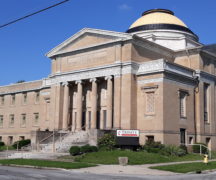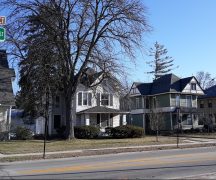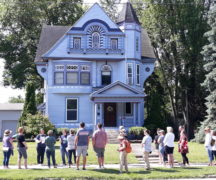(Submitted by the BG Historic Preservation Commission)
Nestled on a corner between the Wood County Courthouse and downtown Bowling Green, at 237 N. Prospect St., stands an eye-catching house with its plaque that reads “The Painted Lady, Built 1878.”
The house is Bowling Green’s historic building of the month.
The house was constructed by master builder George Munshower of Bowling Green in the Queen Anne architectural style. Features that place the Painted Lady within this style include a front-facing gable, irregular roof shapes, and stained glass in the front windows. Three partial porches are accented with spindle work, and corner windows display gingerbread cutouts.
While the architecture of the Painted Lady is in Queen Anne style, its nickname dates to the more recent Colorist Movement, a trend that began in San Francisco in the 1970s when homeowners adorned their Victorian-era houses with multiple colors of paint and called them “Painted Ladies.”
In 1980, the home on North Prospect Street was repainted in Wedgewood Blue, Canary Yellow and Navajo Red and thus became the Painted Lady of Bowling Green. These colors, since changed over the years, emphasize the home’s ornate trim panels, displaying flowers, leaves, and fruit, and its scalloped shingles. The original color palette is unknown, but multiple paint colors were likely used when it was built.
The Painted Lady was originally a single-family home with 14 rooms. The first owner of the house was Julius D. Bolles. Bolles had served in the Ohio Volunteer Infantry Company B, 111th Infantry, during the American Civil War. He was captured in 1863 in Knoxville, Tennessee, when both his commanding officers fell in combat and command of the company fell to him. Outnumbered by Confederate forces, Bolles remained a prisoner of war in Richmond, VA, until his exchange in 1864.
At war’s end, Bolles and his brother Charles opened a dental and pharmaceutical operation in Northwest Ohio. Bolles spent the rest of his life in Bowling Green, marrying Amorette M. Foote in Wood County in 1878. In partnership with physician and pharmacist Andrew Manville, Bolles operated a drugstore on South Main Street. Bolles also served briefly as Bowling Green’s postmaster. He and his wife had nine children.
After Julius Bolles’s death in 1914, his wife Amorette obtained the property which she operated as a boarding house for BG college students. Upon her death in 1930, the home and property went to the family estate.
The 1930s, clearly a tough time financially for many of the Bolles siblings, saw acrimony among them as each was to obtain one-ninth of the land but they had difficulty managing the demands of the mortgage and liens. When they could not agree on how to share the property, litigation among several of the siblings continued throughout the decade before the property was auctioned in a sheriff’s sale in 1940. Each sibling, and a couple of local banks, received a portion of the sale. A younger son, Howard, succeeded in purchasing the house soon after, thus keeping it in the family.
Howard Bolles remained in the home for decades, and it was in 1980 that the home saw significant renovations. Howard Bolles’ daughter, Mary Stoots, transformed the house into business space and had the exterior repainted in 1980. The first businesses that planned to occupy the house were a restaurant called The Greenery and a bridal shop; however, the property did not remain business space for long according to city directories.
Howard Bolles sold the home in 1984 to Dr. Said Shehata, a family physician who emigrated from Egypt to the U.S. and eventually settled in Bowling Green to open his practice. Shehata, interested in real estate investments and rental properties, was the last individual owner of the Painted Lady. It has since been sold to rental companies and remains divided into several apartment dwellings.
(This Building of the Month submission is the result of a collaborative effort by students in BGSU’s Local History seminar taught by Dr. Rebecca Mancuso. Students Patrick Cook, Chase Fleece, Jeffery Hughes, Andrew Kistler, Chloe Kozal, Jack Lawrence, Peter Limbert, Hope London, Alexander LoPresto, Evan Nagel, Riley Peterson, Gabriel Rodriguez, Cecilia Seibert, Sarah Urbank, and Shelby Vasko worked together to create a narrative of this Victorian home.)
Nominate Historic Building or Site




